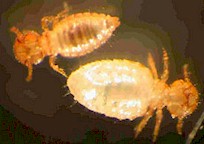Lice are small insects (1 to 5 mm) without wings. Some species suck blood and belong to the order Phtiraptera. Poultry lice belong to a different group called Mallophaga.
Cattle, sheep, goats, pigs, dogs, cats, humans and many other mammals as well as birds can be infested by lice, and this can happen everywhere in the world. The "good news" is that lice are very species-specific and dog or cattle lice won't infest sheep, or pigs, or cats, or humans, etc. or vice-versa.
Infections with lice are technically called pediculosis.
Life cycle of lice

Lice spend their whole life on the same host: transmission from one host to another one is by contact. Transmission from herd to herd is usually through introduction of an infested animal, but flies may also occasionally transport lice.
Lice undergo an incomplete metamophosis. The life cycle takes about 1 month to complete. Each female deposits 20 to 100 eggs (nits) during her lifetime. She deposits them one by one on single hairs of the host, or on the feathers of birds. Incubation lasts 4 to 20 days. Larvae and nymphs look like adults but are smaller. Adult life lasts 2 to 6 weeks. Off the host most lice survive only for a few days.
Chewing lice feed on skin and hair debris as well as on skin secretions. The other species have mouthparts adapted for piercing the skin and sucking blood. The biting or chewing activity of lice is very irritant and stressing for the hosts: they will scratch and rub intensively and this can reduce performance (milk and wool production, weight gain, egg laying, etc.) and cause loss of hair and skin injuries.
In regions with a cold season (e.g. Europe) lice infestations in livestock develop mostly in winter and peak in early spring. Usually infestations decline during the hotter season. Stabling the animals during the winter season favors overcrowding, which makes contact transmission easier. The dense and humid hair coat in winter offers an excellent environment for lice development as well.
Click here to learn more about the general biology of insects.
For more information on the biology, control, and prevention of lice infestations visit the specific articles in this site (clink on the links below or on the corresponding menu):